| 1 | Dugite |
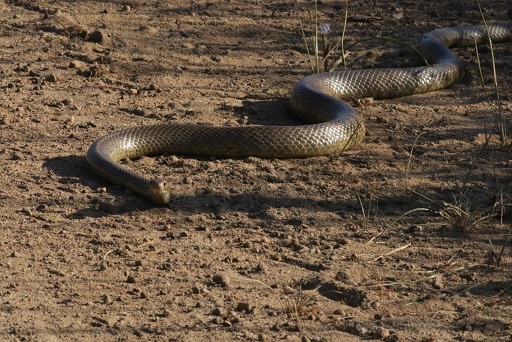
A large venomous snake, which belongs to the same Pseudonaja family of eastern brown snakes. Dugites are found in the southern half of western Australia, and are encountered commonly during the day. Their habitats are manifold, and include coastal dunes, woodlands and shrublands. Dugites also love manmade habitats such as golf courses, parks and agricultural fields, and are particularly abundant in the metropolis of Perth.
Dugites have black eyes, and a slender head which is barely separable from the neck. This is an unpredictable species. Their default is to slither away shyly, but dugites will also attack in random cases. A few deaths have happened, the most recent being a 2015 woman from Fremantle, who collapsed on the way to the car. In 2011, a 7 year old boy was bitten in bed when a dugite slithered in and curled around his arm, but he survived after prompt antivenom treatment.
Dugites prefer their scaled cousins for prey, but are flexible. According to a 2017 study, their prey consisted of 38.4% mammals and 61.6% reptiles. A decent chunk of mammals were the introduced house mouse. Native Australian prey included the southern marbled gecko, southwestern cool-skinks, and common south-west ctenotus.
| 2 | Desert death adder |
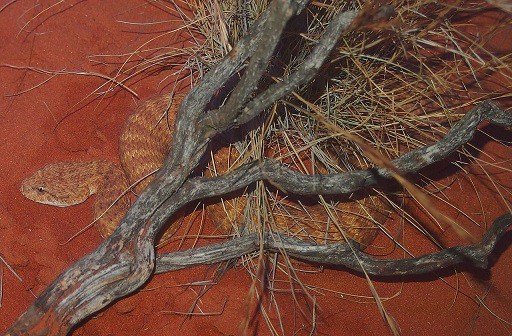
The desert dwelling cousin of the common death adder near Sydney. This is a separate species called Acanthophis pyrrhus, which inhabits most inner regions of Western Australia, skipping civilised Perth. There’s one obvious physical difference: Acanthophis pyrrhus is a sandy beige colour, to blend with sand. Many have a reddish tone, blending in with clay-rich soils.
You won’t find desert death adders by a public bus stop, as they prefer arid regions, where they wait in spiky porcupine grass to ambush rodents walking past. Desert death adders rear their heads in rocky outcrops and sandy ridges, and reach a maximum of 70cm.
Desert death adders have a negative and positive side. Firstly, they’re difficult to spot, with their supreme camouflage against the arid land. But secondly, they only bite if prey (or a human) strays extremely close. Even if you don’t spot the desert death adder, you’ll probably escape untouched, never knowing how close you strayed. This snake lays live young, up to 13 per litter. They eat a varied diet, but adults shift towards mammals, while newborns rely on lizards.
| 3 | Desert banded snake |
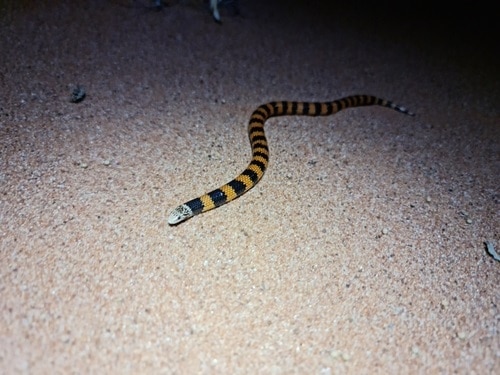
A small snake which poses no threat to humans. Simoselaps bertholdi measures 20-30cm, and the longest on record was just 33cm. There’s probably longer ones hiding in the outback which haven’t been measured, but more than 40cm is unlikely. Desert banded snakes (Simoselaps bertholdi) inhabit arid areas like shrublands, but also woodlands, where they lurk under fallen timber. They’re excellent burrowers in dry soils, and will often poke just their head out, watching the world go by.
Simoselaps bertholdi have alternating orange and black bands, evenly spaced. Contrasting against this is a white head. It’s difficult to tell from a distance, but Simoselaps bertholdi has vertical, elliptical pupils like a viper. If disturbed by humans, then they almost always flee for cover.
This snake has a very specific diet. 90% is lizards of the Lerista family, and in this 2008 study, all were one species: the northwestern sand slider (Lerista bipes). There was also an ant in their stomach, but this was deemed accidental. This is the most common of the Simoselaps snake family, which has 12 members in Australia.
| 4 | Pygmy python |
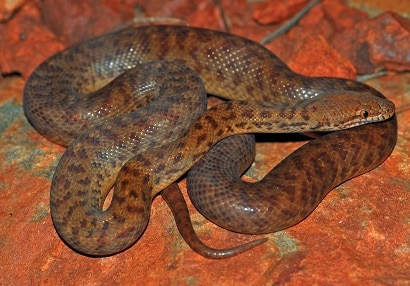
This python won’t be seen by citizens of Perth. It lives mainly in the bone dry arid region of Pilbara, a former gold mining hub. Pygmy pythons live up to their name and average at 40-60cm. They pose no threat to mankind and live well away from human civilisation. To avoid the burning heat, they spend much of their day in termite mounds, resting in the hollow centres. They sometimes share these with other snakes like black-headed pythons and mulgas.
Pygmy pythons are a popular species in captivity, where they can reach 25 years old. Leading a sedentary lifestyle in the wild translates well to a sedentary lifestyle in an enclosure.
This species belongs to the same family as children’s python, but is significantly shorter. Pygmy pythons eat a mixture of reptiles and mammals. Bats are one of their favourites, and in the many hilly outcrops of Pilbara, they rest by the dark entrances of caves to ambush roosting colonies. Some pythons like reticulated pythons are known to invade supermarkets or alleyways in Singapore. Pygmy pythons prefer desolate areas, in the vast outback of western Australia.
| 5 | Bardick |
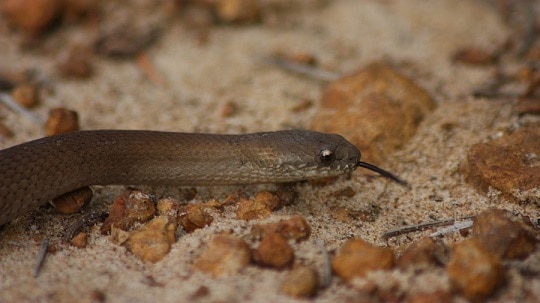
The bardick is a venomous snake found mainly in the southern portions of Western Australia. They’re the only member of the Echiopsis family, and prefer areas with some sort of low vegetation to hide in. That means coastal dunes interspersed with grasses, meadows, mallee woodlands, heathland and the edges of pasture. Bardicks are shy and like to stay below cover if possible. They’re nocturnal, and will flatten themselves to look larger if disturbed. They default to hiding, but will turn aggressive if repeatedly harassed.
This species reaches a maximum of just 57cm. Bardicks are venomous, but no real threat to human beings. No human deaths are confirmed. Their venom is weak, nothing close to a dugite’s or tiger snake’s. Very little is known apart from the venom containing neurotoxins.
Its toxin profile seems similar to a death adder’s, as a dog which was bitten by a bardick recovered well after receiving death adder antivenom. Likewise, a human being was bitten by a bardick and only suffered mild symptoms, but a snake venom detection kit produced a verdict of death adder venom.
| 6 | Half-girdled snake |
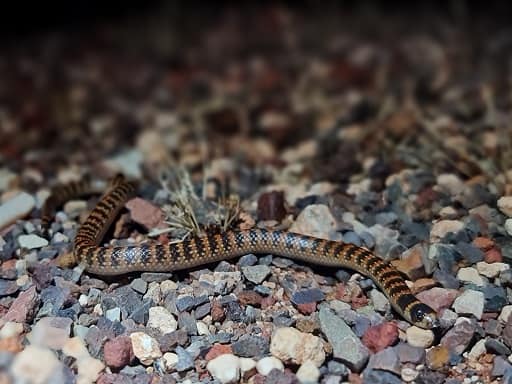
A harmless species which sticks to the ground, and disappears into upper layers of soil. Brachyurophis semifasciatus averages at 25cm, and preys almost entirely on reptile eggs, hidden in soil hollows. They have contrasting orange and black bands, which are faded rather than ultra sharp and vivid. Their tongue has a white tip, and they have round black eyes.
Brachyurophis semifasciatus might be a snake, but it’s no more dangerous than a shrew or vole in the English countryside. Half-girdled snakes will instinctively dart away if frightened, and almost never bite. This is a harmless part of Australia’s wildlife which is of no concern at all. This species has a colony in Queensland, but Western Australia is their main base, particularly the southern portions and outskirts of Perth.
Half-girdled snakes are a burrowing species, with a noticeably pointy snout, which allows them to effortlessly shift substrate aside. They appear in various habitats, including dry woodland, humid forests, arid scrub and hummock grasslands, and coastal dunes. The only constant feature is relatively soft soils to dig in.
| 7 | Reticulated whipsnake |
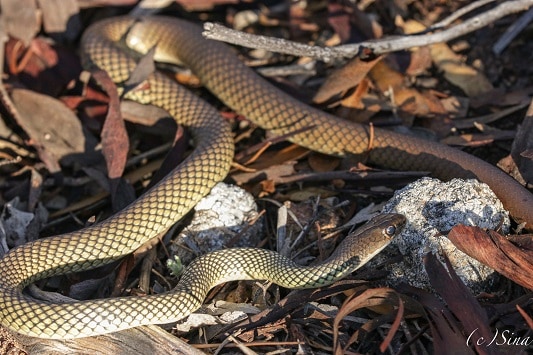
The western relative of the yellow-faced whipsnake, which is common near Sydney. The reticulated whipsnake (Demansia reticulata) lives solely in Western Australia, covering a huge swathe of the coast. This species averages at 1 metre, and is found in rocky regions, semi-arid plains and coastal dunes. This is a venomous species which is capable of causing swelling and pain, but not death. Unlike a dugite, reticulated whipsnakes never appear in urban environments like parks.
The reticulated whipsnake is easy to recognise, as it’s a snake of two halves. Their upper body is pale green, with a black netted pattern. Their lower body and tail keeps this pattern, but is red instead. Their personality is also split. Though reticulated whipsnakes try to avoid humans, hiding in dry bushes, they’ll bite aggressively if trodden on or picked up.
Reticulated whipsnakes are also recognisable by a large black patch below their eye. Yellow-faced whipsnakes share this patch, but the two species don’t overlap, so there’s no chance of confusion.
| 8 | Western tiger snake |
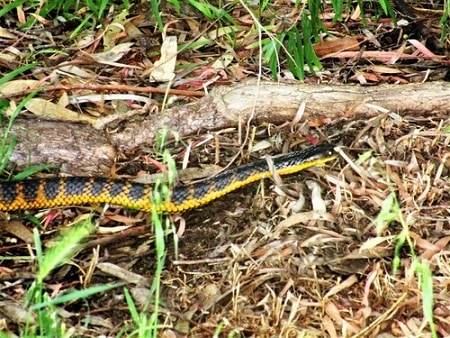
A subspecies of the tiger snake found in western Australia. Compared to eastern forms, the western tiger snake (Notechis scutatus occidentalis) has more vividly contrasting colours, with a jet black base overlaid with yellow stripes. The belly is yellow as well, and this subspecies is generally smaller, particularly those near Perth.
This is one of the most commonly encountered snakes in Western Australia. They’re most common in the southern portions, as they require healthy moisture levels. They’re particularly abundant in the outskirts of Perth. Western tiger snakes are confirmed to prey on the quenda, AKA the western brown bandicoot.
Like eastern forms, they generally stick to the ground, climbing trees only rarely. They’re not aquatic, but will take to the water when necessity drags them there. In Herdsman Lake, 6 kilometres northwest of Perth, scientists watched as a western tiger snake fled underwater and stayed below for 18 minutes, 36 seconds before surfacing for a breath. A previous observation recorded one holding its breath for 20 minutes.
| 9 | Mallee black-banded snake |
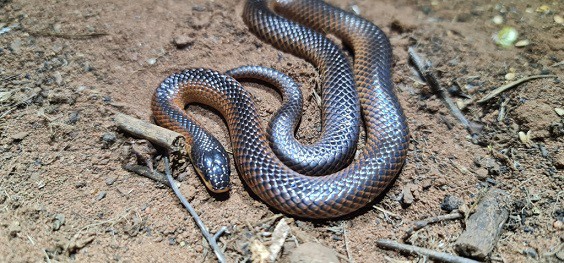
Though Australia is home to the inland taipan, the most venomous snake on Earth, and rampaging mulgas which would swallow you whole and forget about it within minutes, these horrors are giving its other snakes a bad name. Another chunk of Australia’s snakes are humble, and simply trying to eek out a living in a parched arid landscape.
One of these is the Mallee black-backed snake (Suta nigriceps), which measures 30-50cm and is most common in southern parts of Western Australia. This mildly venomous species gets its name from its spine, which is easily the darkest part of its body. Its flanks are a dark bronze, while its belly is the complete reverse, with a snowy white tone.
Though there’s no virtually no research on the venom’s toxin composition, Suta nigriceps are considered to be harmless to humans. They have a calm and placid temperament, and no bites are confirmed. Mallee black-backed snakes have round pupils and a friendly expression when viewed up close. One study found that 41/44 (93.2%) of its prey were lizards, and their favourite family was the Menetia dwarf skinks.
| 10 | Crowned snake |
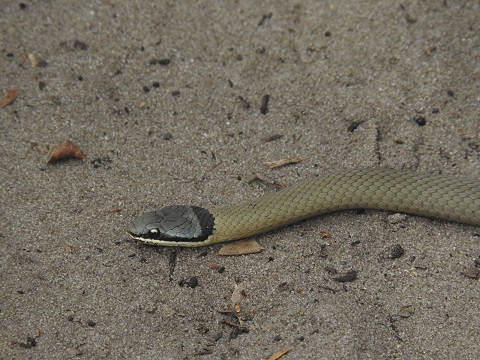
An easy snake to recognise, because of their signature crown. Crowned snakes mostly have an orange body with green tinges, and a bright orange belly. This is consistent from tail to head, but at the neck, a black band appears, and on the head, a grey helmet. There’s also a creamy patch just above their mouth, contrasting sharply with black.
Crowned snakes are most common in southern Western Australia. They’re common near Perth and reach their northern limit at the town of Muchea, fizzling out afterwards. Rather than scorched deserts, they need moist areas with plenty of vegetation, such as swamps, woodlands, and heathland. A cornered crowned snake will first freeze, which allows you to approach close. Then they’ll suddenly reactivate and flee for the bushes, squirming madly in desperation to escape.
Crowned snakes move by day, and rely on lizards and frogs for their prey. They need a water source to survive, and if wetlands are removed from an area, due to creeping urbanisation, the local crowned snakes will plummet. This is a venomous species, but no research has been conducted. The precise deadliness and toxin profile is a mystery.
